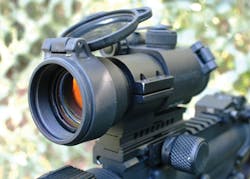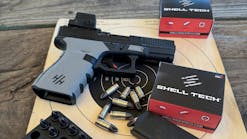Given the length of time the United States Military Special Operations Command has been using some type of red dot optic, you’d assume everyone in the American L.E. community would “get it” when it comes to dot sights. Sadly, it is apparent to me that many don’t get it. No so long ago a veteran officer remarked about my Aimpoint optic, “Those are cute toys, but I wouldn’t bet my life on one.” I don’t suppose that the boys in CAG, MarSoc, and the Teams look at their red dot optics as toys and I can’t imagine operators who subject optics to more rigorous field use.
I will concede that twenty-five years ago battery-life for red dot optics was an issue to be considered. Some optical sights were stouter than others and the electronics in many units could be temperamental. I’m penning this review is 2012, not 1990, and the optics available to today’s law enforcement officer are the best they’ve ever been.
Optics for Rifles and Shotguns
I’ve been using the Aimpoint Micro T-1 red dot optic on rifles and fighting shotguns on and off for the last five years and have had tremendous success with several different units. After the 2012 SHOT Show I picked up their new model the Patrol Rifle Optic (PRO).
The Micro T-1 comes with a Picatinny base to mount to a shotgun receiver rail or carbine. Aimpoint sells a “same plane” riser to raise the T-1 up to be used on an M4/AR so the user can co-witness the optic with their back-up iron sights. Battery life on the T1 is ridiculously long. Starting with a fresh CR 2032 Lithium battery and the optic set at a medium brightness setting you can expect 4-5 YEARS of run time (50,000 hours). Yes, years, not hours. Mount the optic, zero it, put the setting on five or six and leave it alone. It’s that simple.
The PRO comes with a quick-mount platform to install on your M4/AR Picatinny receiver rail. This optic come with a mount and is set the correct height co-witness with your back-up sights. The PRO red dot runs on a single 3V 123 Lithium battery. Run time from the factory says 30,000 hours when set on the 7 to 10 brightness settings.
The entire unit weighs 11.6 ounces including the mount. Windage and elevation adjustments are simple and the on/off adjustment knob can be operated easily, even with a gloved hand. One of the most attractive features of the PRO is its price tag. I found them at the Brownells.com website for only $400.95.
Real World Use
Many of the red dot sight detractors claim that they can do the same thing with their standard iron sights as they can with a dot sight. This claim generally comes from time spent on the practice range not in the real world. A guy will lay down behind a carbine with a red dot and then iron sights on a calm and sunny afternoon. He’ll shoot both and say, “No difference, I’ll save my money”. Square range shooting is not the real world.
Earlier today I was reviewing a surveillance video of a shooting. The gunman in question missed his victim from ten feet despite the fact that the shooter and his victim were both standing still. Yes, he was using a handgun but, fortunately for the victim, the shooter made the common mistake of looking OVER his gun and fixating on the target. This is a common error humans will make in the heat of the moment. Their natural tendency is to fixate on the thing to be shot, not the front sight. Yes, we can train to deal with this issue, but it is still a genuine concern.
When you train and practice with a red dot optic, transposing the red dot on the target becomes a part of the shooting equation. The shooter learns to identify the red dot on the target as their “Go Code” (time to press the trigger). They mentally train themselves to associate the red dot and the target together as the correct sight picture. Rather than fighting against the natural human tendency to look at the target, not the front sight, the target and the sight become one in the same. It’s okay to look at the target because you are looking at the target through the window of your optic.
All the of the previously mentioned issues become increasingly important if the target is moving, the shooter is moving, and the light conditions are poor. If you are fortunate in a gunfight you will be in shadow and your target in the light. That’s a great tactic but dark shadows make it hard to see your front sight.
Coming Soon: Pistols
I have it on good authority that the boys at Bragg are heavily involved in training with service pistols that employ varied red dot optics. These aren’t IPSC competition shooters, but guys training to fight with red dots on their handguns. While the mechanics of using a dot sight on a pistol vary from a shotgun or carbine, the concept is the same.
My good friend, David Biggers of XS Sight fame, and now head of his own consulting company is working diligently behind the scenes with both optic and pistol makers to see duty pistols outfitted with red dot sights from the factory, not aftermarket.
Another good friend, James Yeager, has reported that several competent and serious shooters have taken his Fighting Pistol courses with a red dot mounted handguns. None of the shooters thus far have had any issues or negative experiences.
You Can’t Buy Your Way Around Training
If there is a downside to red dot optics it could be the misconception that putting a dot sight on a firearm somehow negates the need to train or practice with said gun. A red dot sight enhances the shooter’s ingrained ability. It is not a substitute for it. Another friend of mine, who makes his living as a professional shooter remarked, “The dot doesn’t press the trigger for you. You can’t make up for a lack of skill by purchasing expensive gear.”
Should you be able to use traditional iron sights and have them mounted on your gun along with a red dot? Most certainly you should. Red dots aren’t perfect, they are devices made by men. However, the new optics are tough as nails when you buy them from a reputable company.
One SOF trooper put it to me like this when discussing the Micro T-1. “We got took incoming rockets on the way to the hit. I was thrown from the vehicle and landed so hard on my M4 I thought I might have bent the barrel. We fought through it and not only did my Aimpoint not break, it didn’t even lose its zero.” a resounding endorsement to say the least. For more information contact www.aimpoint.com

Paul Markel
Mr. Markel is a former United States Marine, Police Officer, and has worked as a professional bodyguard both in the U.S. and overseas. A Subject Matter Expert on Small Arms and Tactics, Markel has provided instruction to law enforcement and U.S. Military troops.
As a recognized author and writer, Paul has penned several hundred articles published in numerous professional journals and trade periodicals. Topics include firearms training, use of force, marksmanship, less-than-lethal force options, product reviews and evaluations, emergency medical care, and much more. Sought after as a public speaker, Mr. Markel is at home in front of an audience large or small.
Follow Mr. Markel's instructional show: http://www.studentofthegun.com



